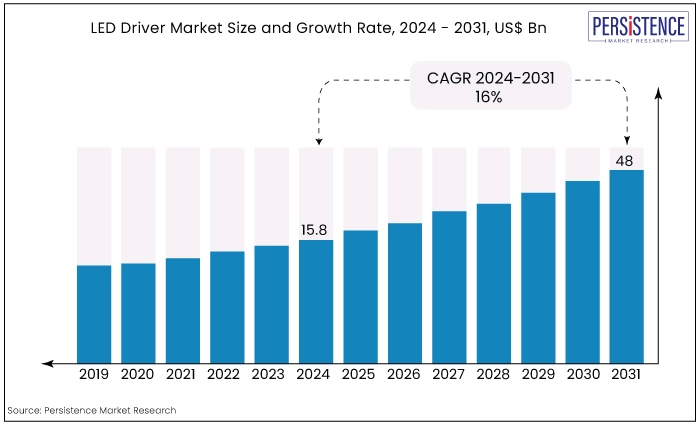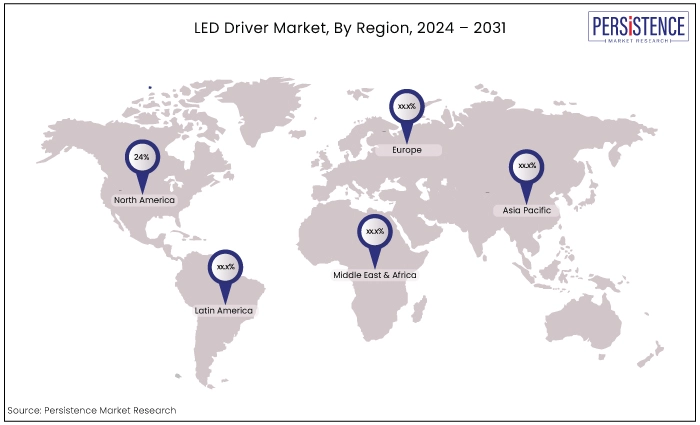Industry: Semiconductor Electronics
Published Date: July-2024
Format: PPT*, PDF, EXCEL
Delivery Timelines: Contact Sales
Number of Pages: 175
Report ID: PMRREP34705
The market for LED driver is estimated to reach a valuation of US$48 Bn by the year 2031, at a CAGR of 16%, during the forecast period 2024 to 2031.
Key Highlights of the Market
|
Market Attributes |
Key Insights |
|
Market Size (2024) |
US$15.8 Bn |
|
Projected Market Size (2031) |
US$48 Bn |
|
Forecast Growth Rate (CAGR 2024 to 2031) |
16% |
|
Historical Growth Rate (CAGR 2018 to 2023) |
14.4% |

The global LED driver market is experiencing tremendous growth due to the widespread adoption of LEDs as a substitute for traditional lighting. LEDs offer more advantages compared to traditional lighting products, which include an extended lifespan of LED, enhanced energy efficiency compared to traditional products, compact size, and reduced heat emission.
The growing prevalence of smart homes has resulted in a significant demand for Internet of Things (IoT) linked lighting solutions, which has driven the global market growth.
The market is experiencing growth due to various initiatives launched by countries globally to promote energy conservation. The rapid advancements in lighting technology have facilitated energy conservation and efficiency, hence bolstering the need and fostering the market expansion.
The growing adoption of LED lighting in diverse sectors such as horticulture, automotive, indoor, and industrial has contributed to the expansion of the LED driver business. This is primarily driven by the increasing need for enhanced lighting solutions in these sectors.
The increasing utilization of in gadgets such as calculators is anticipated to fuel the advancement of the LED driver industry.
The global LED driver market has exhibited robust growth from 2019 to 2023, driven by technological advancements, increasing adoption of energy-efficient lighting solutions, and growing demand across various end-user industries.
In 2019, the market laid a solid foundation for subsequent growth. The market benefited from the ongoing transition towards energy-efficient lighting solutions, driven by stringent regulations aimed at reducing carbon emissions and promoting sustainable practices worldwide.
Key regions such as North America, Europe, and the Asia Pacific witnessed increased investments in infrastructure development, smart city projects, and commercial applications, boosting the demand.
The years 2022 and 2023 witnessed accelerated adoption driven by expanding applications in automotive lighting, outdoor displays, horticultural lighting, and healthcare sectors.
Market players intensified their focus on innovation to cater to diverse customer requirements, including miniaturization of drivers, enhanced power efficiency, and compatibility with IoT-enabled lighting solutions.
Moreover, the integration of wireless connectivity and sensor technologies in LED drivers facilitated advanced lighting control and energy management capabilities, further boosting the market demand.
Growing Adoption of LED Lighting Solutions
The rapid adoption of LED lighting solutions is another major driver of the LED driver market growth. LEDs offer numerous advantages over traditional lighting technologies, including longer lifespan, lower energy consumption, enhanced durability, and superior light quality.
As the cost of LED lighting continues to decline and awareness about its benefits increases among consumers and businesses alike, there has been a widespread shift towards replacing conventional lighting systems with LEDs.
LED drivers are essential components that ensure the proper operation and performance of LED fixtures by regulating current and voltage levels, thus supporting the widespread adoption of LED lighting solutions globally.
Shift Towards Smart & Connected Lighting Systems
The growing market trend towards smart and connected lighting systems represents a significant opportunity for the market. Smart lighting solutions leverage IoT technology and wireless connectivity to enable remote control, automation, and energy management capabilities.
LED drivers play a critical role in these systems by enabling dimming, colour tuning, and integration with sensors for occupancy detection and daylight harvesting.
The demand for intelligent lighting solutions in smart homes, smart cities, and commercial buildings is driving the adoption of advanced LED drivers that support these functionalities.
Increasing Applications Across Diverse End-Use Industries
LED lighting and consequently LED drivers find applications across a wide range of industries, including residential, commercial, industrial, automotive, healthcare, and horticulture.
In residential settings, LED drivers support lighting fixtures for homes, apartments, and outdoor spaces. Commercial buildings utilize for office lighting, retail displays, and hospitality environments. Industrial sectors employ them in warehouse lighting, manufacturing facilities, and outdoor area lighting.
Automotive LED drivers power vehicle headlights, taillights, and interior lighting systems. Their versatility and efficiency make them indispensable across diverse applications, driving market expansion across different sectors globally.
Technological Limitations, and Compatibility Issues
Technological limitations and compatibility issues represent another significant restraint for the LED driver market. LED drivers must be compatible with a wide range of LED fixtures, including those with varying voltage and current requirements, dimming capabilities, and integration with smart lighting systems.
Issues related to compatibility, performance, and reliability can hinder market adoption and customer satisfaction. LED drivers must be carefully matched with specific LED fixtures to ensure optimal performance and longevity.
Variations in voltage, current ratings, and dimming protocols among LED products can lead to compatibility challenges, requiring thorough testing and certification processes.
Inconsistent dimming performance and flickering can occur when LED drivers are not adequately designed or when compatibility issues arise with dimmer switches or control systems. These issues can impact user experience and perception of LED lighting quality.
The reliability and durability are critical for ensuring the longevity of LED lighting systems. Factors such as thermal management, surge protection, and component quality can influence the reliability under varying environmental conditions, affecting overall product performance and customer satisfaction.
Expansion of Smart Lighting Solutions
Smart lighting solutions represent a compelling growth opportunity for manufacturers and suppliers. Smart lighting systems leverage IoT technology to enable remote control, automation, and connectivity features.
LED drivers play a crucial role in these systems by providing dimming capabilities, colour tuning, and integration with sensors for enhanced energy management and user convenience.
LED drivers can be integrated with IoT platforms to enable advanced functionalities such as occupancy sensing, daylight harvesting, and personalized lighting controls.
Industry participants can capitalize on the demand for intelligent lighting solutions in smart homes, smart buildings and smart cities by developing IoT-compatible drivers that support seamless connectivity and interoperability.
Smart lighting solutions powered by LED drivers offer opportunities for optimizing energy consumption through real-time monitoring and analytics. This capability not only enhances operational efficiency but also supports sustainability goals by reducing carbon footprints and operational costs for end-users.
Drive IC Segment Dominates with over 48% Market Share
|
Market Segment by Component |
Market Value Share 2023 |
|
Driver IC |
42% |
Based on component type, the LED driver market is further segmented into driver IC and discrete component, where the driver IC segmentation dominates the market share.
To provide optimal brightness and longevity, it is necessary to supply LEDs with a continuous current. Driver integrated circuits (ICs) provide exact regulation of current, guaranteeing that light-emitting diodes (LEDs) are supplied with a uniform and precise current, irrespective of fluctuations in input voltage or temperature.
In addition, driver ICs frequently have dimming and control functionalities, enabling users to modify the brightness or colour temperature of LED lighting systems.
These integrated circuits (ICs) offer interoperability with various dimming techniques, including analogue, digital, or wireless control, allowing for flexible lighting control choices. The projected advantages linked to driver IC are expected to boost the expansion of this category over the forecast period.
Type A Lamp Leads the Way by Luminaire
|
Market Segment by Luminaire |
Market Value Share 2023 |
|
Type A Lamp |
32% |
Based on luminaire segmentation, the market is further segmented into reflectors and type A lamp, where the type A lamp segment dominates the market.
The type A lamp is a specialized LED driver that is specifically built to run and supply power to type A bulbs. LED drivers are electronic devices that oversee and manage the power supply to LEDs, guaranteeing accurate voltage and current levels for best performance.
Type A lights are retrofit bulbs designed to replace conventional incandescent bulbs without necessitating modifications to the existing fixtures or sockets.
These lights often feature a design resembling traditional A-shaped incandescent bulbs and are equipped with a medium screw base, either E26 or E27. Furthermore, these lamps are capable of being used with ordinary socket types and may be effortlessly incorporated into pre-existing lighting systems.
Primacy of North American Prevails Throughout the Forecast Period
|
Region |
Market Value Share 2023 |
|
North America |
24% |
North American region is experiencing significant growth due to government regulations promoting the use of energy-efficient lights. Further, the increasing awareness of the benefits of energy-efficient lights, decreasing prices of LED products, and the subsequent rise in the adoption of LED solutions in commercial, residential, and industrial applications, drives the market forward.
The increasing utilization of intelligent lighting solutions to enhance lighting efficiency and achieve energy conservation in commercial settings is a significant driver of regional market expansion.
Further, the market in the U.S. held the largest market share in the LED driver industry. The expansion of the U.S. can be attributed to the rising need for energy-efficient lighting solutions in residential, commercial, and industrial sectors.
Furthermore, the high growth of the U.S. LED driver market can be attributed to the progress made in semiconductor technology and the government's efforts to encourage sustainable lighting through incentives.

The LED driver market is highly competitive and dynamic, characterized by the presence of several established players and a growing number of new entrants aiming to capitalize on the expanding demand for energy-efficient lighting solutions.
This competitive landscape is shaped by various factors that influence market dynamics, including technological innovation, product differentiation, strategic partnerships, and geographic expansion strategies.
Geographic expansion strategies are instrumental for market players seeking to capitalize on regional growth opportunities and strengthen their market presence globally.
Leading companies invest in expanding their manufacturing facilities, sales offices, and distribution channels in key regions such as North America, Europe, Asia Pacific, and Latin America.
By establishing a strong local presence, companies can enhance customer support, improve supply chain efficiency, and adapt their product offerings to meet regional regulatory requirements and market preferences.
Recent Industry Developments
|
Attributes |
Details |
|
Forecast Period |
2024 - 2031 |
|
Historical Data Available for |
2018 - 2023 |
|
Market Analysis |
US$ Billion for Value |
|
Key Regions Covered |
|
|
Key Companies Profiled |
|
|
Pricing |
Available upon request |
By Component
By Luminaire
By Application
By Region
To know more about delivery timeline for this report Contact Sales

The global LED Driver market is estimated to exhibit a CAGR of 16% during the forecast period.
North America is the leading region in the market.
The global LED Driver market is segmented based on component, Luminaire and application.
ACE LEDs, Microchip Technology Inc., Cree LED, HLI SOLUTIONS, INC., and Signify Holding, are some of the major key companies in the market.
Driver IC is the dominant component type in the market.